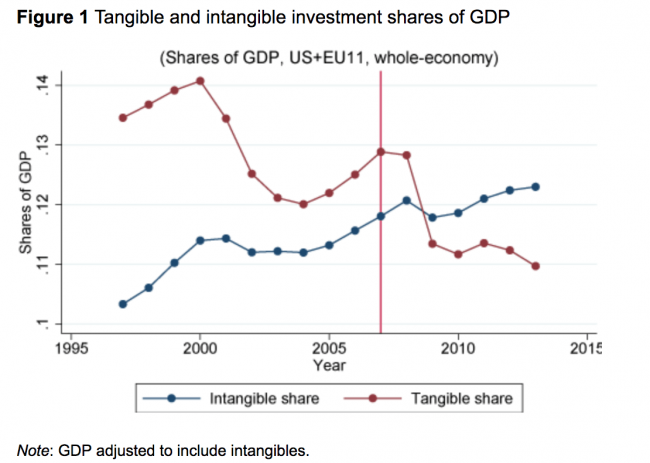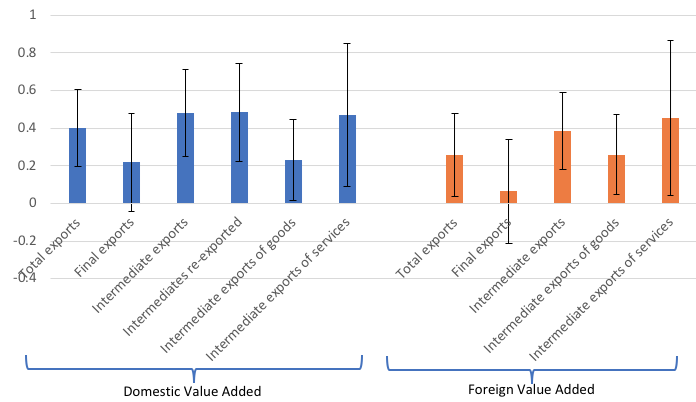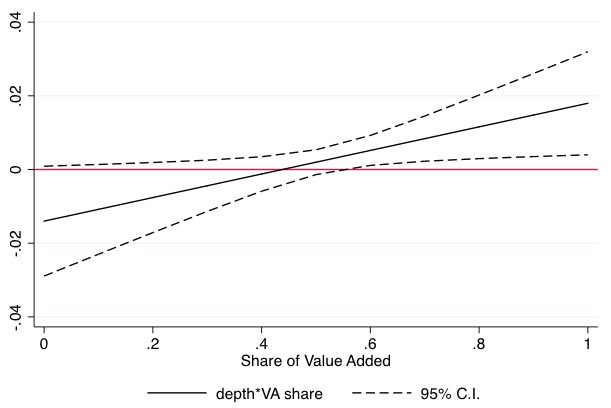http://jaredbernsteinblog.com/prepping-for-friday-whats-trend-gdp-growth/
This Friday morning at 8:30, we'll see the first estimate of GDP for 2018Q2. Various trackers have it coming in at or above 4% (that's the real, annualized quarterly growth rate). It's that ballpark correct, as I expect it is—the trackers use much of the same incoming data as BEA—it will be a big political football, but that's not the purpose of this post. Here, I'd like to think about the best way to pull out the underlying trend of real GDP growth.
While team Trump will be going bananas for any number with a handle of 4 on it (as would, to be fair, even a normal administration), it's widely agreed upon by long-time GDP watchers that any single quarter should be down-weighted, and even more so if it's an outlier (i.e., well above or below trend). But the concept of outlier implies the existence of a known trend, and that's where things get a bit more confusing these days.
The first thing you want to do when hunting the trend is to get away from the noisy, annualized quarterly growth series. Figure 1 shows, for example, how the year-over-year change cuts through the volatile annualized quarterly data (for all of these figures I've plugged in 4.5%, as per the Atlanta Fed's GDPNow, for 2018Q2).
Source: BEA
The end of the yr/yr series, juiced in part by my plug-in, shows a nice acceleration to around 3%, but it also shows rates of 3% achieved pretty recently, around 2014-15. Yet, most non-thumb-on-the-scale analysts estimate trend GDP growth to be closer to 2 than 3. I agree, meaning there is still be too much noise in the yr/yr series to pull out a reliable signal of the underlying trend.
If you didn't know better, you'd use a simple HP filter to pull out the signal and call it a day, as in the next figure (most such examples apply the filter to log GDP, not to its annual change, as I do here, but the reasons to not use this filter pertain here as well). But as Jim Hamilton recently wrote, this approach risks bringing "all kinds of patterns into the HP-filtered series that have nothing to do with the original data-generating process and are solely an artifact of having applied the filter."
Source: BEA, my analysis
The HP filter can be especially misleading at the end of series as its construction leads it to hew too close to the actual data. And that's the part in which we're often most interested.
Hamilton has his own recommended approach (follow the link above), and sure enough, if you run both the HP and Hamilton filters on log real GDP, the Hamilton trend is well below the actual data at the end of the series (remember, all these figures plug 4.5% in for Q2). The Hamilton filter, to its credit, is a tougher customer and requires more convincing than HP before it accepts a more persistent shift in the series, i.e., a change in the trend. The implied recent growth rate of the Hamilton series, btw, is around 2%, which, as noted, many of us still think of as real GDPs trend.
Source: BEA, my analysis
There is, however, the matter of the stimulus, which is clearly pushing growth above that trend rate as fiscal injections of more than $200 billion a year both this and next year are prone to do. Goldman Sachs researchers report a fiscal boost to real GDP growth of a bit north of 0.5 ppt in both 2018 and 2019.
But that's Keynes, not Laffer, meaning once the fiscal impulse fades, it's back down to trend (more precisely, negative fiscal impulse might will take GDP below trend for a few quarters).
So, beyond a wild card I'll note in a moment, GDP is probably growing at a long-term trend around 2%, though near-term quarters will be above trend. And we should get no more elated by the 4.5% on Friday, if that's the print, than we should be disappointed by the 2% final estimate for Q1.
The wild card is this: Though we could use more empirical evidence, I'm increasingly moved by reverse hysteresis arguments, where positive demand shocks can boost the economy's supply side (here's a nice empirical paper with some evidence from Coibion et al written for CBPP's Full Employment Project). To the extent, for example, that the tight job market pulls in more labor market sideliners, there's the potential for faster labor force growth. Also, as Bivens argues: "A 'high-pressure economy' that eliminates the remaining demand shortfall in the U.S. economy and leads to low rates of unemployment and rapid wage growth would likely induce faster productivity growth."
The logic is that firms, in order to maintain profit margins in periods of high labor costs, must find efficiencies they can ignore in slack markets. [What's that? This can't be right because any firm not operating at the edge of their PPF will be forced out of businesses by more productive competitors? Yeah…no.]
Especially given relatively tame (core) price and wage inflation, what's the downside of seeing if he's right?!
At any rate, if BEA delivers unto us a GDP growth rate for Q2 that starts with a 4, go ahead and applaud. Then sit down and back out the trend.
Note 1: I'll rerun some of these figures with the actual estimate on Friday, time permitting.
Note 2: I didn't get into it here, but there are good arguments for gleaning real GDPs trend from sub-measures that leave out volatile components. One popular entry is real final sales to private domestic purchasers, which is C + I – inventories + imports. BEA itself says this series tracks "the more persistent movements in spending by consumers and businesses."
This last figure plots real GDP and real final sales to domestic purchasers, yr/yr. There is less of an acceleration in final sales toward the end of the series, and I like that it's smoother than GDP growth. But since 2010, they seem to telling a similar story.
Note 3: For others who play in this sandbox, what's your preferred method for GDP trend extraction? I only ask that it's a technique we can all try at home, i.e., nothing too esoteric.
-- via my feedly newsfeed




